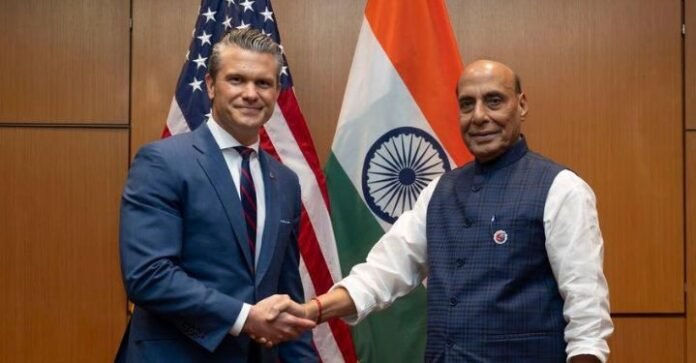In a landmark diplomatic and military development, India and the United States have signed a 10-year defence cooperation framework that underscores their shared strategic interests in the Indo-Pacific, even as both nations navigate simmering tensions over tariffs and trade policy.
The agreement, inked by India’s Defence Minister Rajnath Singh and U.S. Defence Secretary Pete Hegseth in Kuala Lumpur on the sidelines of an ASEAN defence meeting, lays out a decade-long roadmap for collaboration in military technology, industrial cooperation, intelligence sharing, and joint operational planning. Officials from both countries hailed it as a “historic deepening” of the world’s largest and oldest democracies’ defence ties.
A Strategic Leap in Defence Partnership
The new framework agreement replaces the earlier 2015–2025 pact and reflects an expanded scope of cooperation. According to statements from both governments, the pact will focus on five key pillars:
- Joint Research and Development in advanced technologies, including artificial intelligence, unmanned systems, and space defence.
- Co-production and co-design of next-generation military equipment, allowing Indian defence industries to partner with U.S. companies.
- Enhanced interoperability through regular joint exercises, especially in the maritime domain.
- Secure logistics and maintenance agreements, enabling mutual access to military facilities for refuelling, repairs, and training.
- Increased intelligence and cyber cooperation to address regional threats and transnational terrorism.
Secretary Hegseth described the pact as a “cornerstone of regional stability,” adding that “India is no longer just a strategic partner; it’s a trusted defence ally.” Minister Rajnath Singh echoed this sentiment, stating that the agreement “reflects India’s growing confidence as a security provider and its commitment to a free, open, and rules-based Indo-Pacific.”
Context: The Indo-Pacific Equation
The 10-year accord comes amid heightened geopolitical competition in the Indo-Pacific, where China’s growing assertiveness has prompted regional powers to strengthen security partnerships. India, a key member of the Quadrilateral Security Dialogue (Quad) alongside the U.S., Japan, and Australia, views the defence pact as vital to maintaining strategic balance in the region.
Defence analysts note that the agreement elevates India’s position as a key node in U.S. security strategy. “Washington sees New Delhi as indispensable to ensuring maritime security and counterbalancing China’s influence,” says Dr. Meera Krishnan, a senior fellow at the Institute for Strategic Studies in New Delhi. “For India, the deal ensures access to high-end technologies that will modernize its defence ecosystem.”
The pact also aligns with India’s Atmanirbhar Bharat (Self-Reliant India) initiative, which emphasizes indigenous production and technology transfer rather than simple procurement. Under the new framework, several U.S. defence firms are expected to expand joint ventures in India, particularly in aerospace and shipbuilding sectors.
Tariff Troubles Cast a Shadow
Yet, even as defence relations soar, trade friction continues to test bilateral ties. The U.S. recently reinstated certain tariffs on Indian steel and aluminium exports, citing competitive imbalances. India, for its part, has pressed Washington to restore preferential trade status under the Generalized System of Preferences (GSP) and to reduce duties on Indian textiles and pharmaceuticals.
While neither side allowed trade disputes to derail defence talks, the underlying economic discord remains. A senior Indian trade official, speaking on condition of anonymity, said, “The defence relationship is advancing much faster than trade. We are allies in strategy but competitors in commerce.”
Commerce Minister Piyush Goyal expressed cautious optimism earlier this week, noting that a trade pact “could still be reached by the end of the year” if both sides show flexibility. However, observers caution that progress on tariffs may lag behind the strategic agenda.
Industrial and Technological Implications
The defence pact has significant implications for both nations’ defence industries. For India, it offers the chance to become part of the global supply chain for high-value military components and to attract fresh investment in indigenous manufacturing. For U.S. firms, it opens access to one of the world’s fastest-growing defence markets, estimated to be worth over $100 billion by 2035.
Joint initiatives under the new framework include plans for co-developing unmanned aerial systems, naval propulsion technology, and next-generation radar systems. Indian state-owned companies such as HAL (Hindustan Aeronautics Limited) and private conglomerates like Tata Advanced Systems are expected to collaborate with American counterparts such as Lockheed Martin, Boeing, and General Dynamics.
Regional and Global Reactions
The signing of the defence accord was met with both support and scrutiny across the region. Japan and Australia welcomed the move, seeing it as reinforcing collective security efforts in the Indo-Pacific. Meanwhile, China criticized the pact, describing it as a “Cold War-style alignment” that could “destabilize regional harmony.”
Analysts argue, however, that India’s and America’s intentions are defensive rather than provocative. “This is about deterrence, not confrontation,” said Professor William Anderson of Georgetown University. “It’s a recognition that peace through strength remains a valid principle in today’s multipolar world.”
The Road Ahead
While the defence framework is being celebrated as a milestone, experts caution that its success will depend on execution. Past agreements between India and the U.S. often faced bureaucratic bottlenecks, differing procurement processes, and sensitivities over data sharing. Both nations have pledged to streamline coordination mechanisms and establish a joint review body to oversee implementation.
Over the next few months, working groups will begin outlining detailed cooperation projects. High-level meetings between the Pentagon and India’s Ministry of Defence are scheduled for early 2026 to operationalize the framework’s first phase.
Conclusion
The 10-year India–U.S. defence accord stands as a testament to the growing convergence of interests between the two democracies. It sends a clear message that despite trade disputes and global uncertainty, strategic imperatives continue to bind them.
For Washington, it reaffirms India’s role as a central partner in shaping a stable Indo-Pacific. For New Delhi, it secures access to advanced technologies and elevates its global defence stature.
As Minister Rajnath Singh remarked at the signing ceremony, “Our partnership with the United States is not just about security—it’s about shared responsibility. Together, we will ensure peace, stability, and prosperity in the Indo-Pacific and beyond.”

